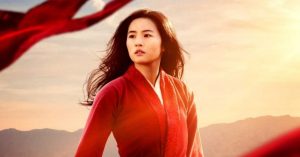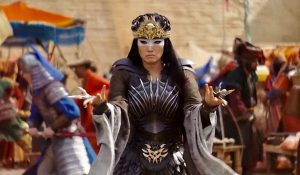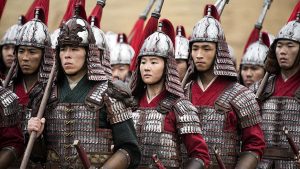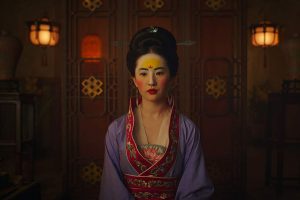Far and away the best of a slew of recent live-action remakes of animated Disney classics, Mulan blends the fantastical whimsy and stylized beauty of the 1998 film with the epic, somber maturity of the ancient Chinese ballad of Hua Mulan (Liu Yifei), finding its balance in a delicate sweet spot that it has difficulty maintaining the whole way through – but it manages, thanks to Niki Caro’s direction and an extraordinary ensemble cast: and in several instances it doesn’t just stay on par with 1998’s Mulan, but dares to soar above and beyond the constraints from which other live-action remakes have suffered. In only a few places does this version of the story falter or fall behind its predecessor.

Nostalgia (and the ways in which it can be exploited for money) has been both the reason why these live-action remakes continue to be made, and also why they often feel watered-down and uninteresting next to their animated counterparts. Afraid to change too much of the “original” stories (I put original in quotes because most of Disney’s classic fairytales are just that; adaptations of far older fairytales), the directors of these remakes choose to simply rearrange plot points inoffensively, and/or bloat the films’ runtimes with filler material: exposition, explanations and lengthy justifications for plot holes in the animated films, and new musical numbers that (with a few exceptions) feel like lackluster imitations of the real thing: though that last problem is made less noticeable when even the live-action recreations of the original songs are usually lackluster imitations (looking at you, the entire soundtrack of 2019’s The Lion King). Mulan, however, never suffers from these problems, because director Niki Caro has made the bold and commendable decision not to lean on nostalgia so heavily, but instead to weave the Chinese source material and the Disney animated film into one beautiful amalgamation of the two that feels like the truest version of the story yet. This decision necessitates removing entire sections of the animated film. Several major characters have been cut out entirely. The animal sidekicks and their hijinks are absent. The songs have been dropped. And most importantly, the tone of the story has changed entirely: Mulan was always one of the funniest, zaniest Disney movies, but this version feels more like an accessible, family-friendly tribute to the wuxia genre’s greatest hits, particularly Crouching Tiger, Hidden Dragon. In retrospect it’s obvious that, while the animated Mulan remains my personal favorite version of the story and my favorite Disney animated movie, this is how the legend of Mulan deserved to be told all along: as a war film with dark, adult themes, masterfully choreographed action scenes, and beautiful, luxurious imagery.
As for Mulan herself, the woman who disguised herself as a male soldier to take her father’s place in battle is a national heroine in China, and it’s no secret that Chinese audiences never liked how she was written in the animated film. This time around, Liu Yifei embodies a quieter, more reserved version of the character, who is hiding her inner power from herself and her family. But the key aspects of Mulan’s personality have not been changed: she is still a strong-willed woman endeavoring to carve out a place for herself in a world dominated by an unwavering patriarchy. If anything, these aspects have only been emphasized through the way the story has changed.

Gong Li’s character, the mysterious and absolutely stunning sorceress Xianniang, balances out Mulan’s storyline with her own sad, cautionary tale. Like Mulan, she is a woman with aspirations and ambitions, but unlike Mulan, she has already fully embraced herself and her truth before the story opens; and it is for that reason that she now finds herself an unwanted outcast on the fringe of society, reviled even by her allies, who feels compelled to try and warn Mulan of the dangers she will face if she ever tries to upset the “natural” order of things. Her complex relationship with Mulan forms the film’s emotional core, and, side-note, has already sparked substantial interest from members of the LGBTQ+ community who have pointed out that, in the original ballad, the character of Xianniang is Mulan’s best friend and maybe love interest. There’s hints of that chemistry in their interactions here, although Mulan has a more explicitly romantic relationship (in fact, too explicit for some Chinese audiences) with a new male character named Honghui (Yoson An), a soldier in her regiment.
Throughout the film, a great deal of the plot revolves around Mulan trying to unlock her qi, an internal life-force that can give her gravity-defying acrobatic and martial arts skills, if only she can learn to control it. Xianniang is already in touch with her own qi, though she has been using it for evil for many years. It is this qi which allows both women to shine most brilliantly in their numerous action scenes, which – thankfully – have not all been revealed in the trailers. Xianniang, in particular, has a lot of tricks and surprises up her long, flowing silk sleeves (which themselves double as weapons designed for quick and easy strangulation of all enemies within about a ten-foot radius).

The animated Mulan had numerous story issues, but none was bigger than the problem with its villain, the Hun leader Shan Yu: who was definitely one of Disney’s most terrifying and threatening villains, but maybe not one of the studio’s most well-written or dynamic. That problem has been solved. The duo of Rouran warlord Bori Khan (Jason Scott Lee) and Xianniang, and the bond of mutual distrust between the two is very well-written. Bori Khan isn’t quite as menacing as his animated counterpart, but he has a much cooler look, a much more personal motive, and a much more compelling performance. Although in the trailers you’ve seen him and Xianniang working together, the movie establishes early on that their pairing is necessary for both to achieve victory, but is by no means motivated by any strong affection for the other. I absolutely love characters who have separate needs and wants, so this development worked for me.
There are several other standouts in the cast who make so much of their roles that they’ve instantly surpassed the animated versions of their characters. Mulan’s father, war veteran Hua Tzo (Tzi Ma), has a much larger role to play in the story, and his character’s kindness and genuine love and respect for his daughters made me very happy to see: I particularly enjoyed watching his internal conflict play out, as he tried to reconcile Mulan’s unconventional dreams with the more strict, uptight wishes of his community and culture. The village matchmaker, no longer a grotesque caricature, has a slightly expanded role and even gets a moment of payoff to her character arc that I never knew she needed. And The Emperor (Jet Li), while no longer charming or sassy, is again less of a caricature and more of an actual character, who even gets to participate in the third act battle. I did miss the antics of the Hua family’s matriarch, Grandmother Fa, but I never once found myself bemoaning the loss of the diminutive dragon Mushu or the lucky Cricket Cri-Kee (oddly, the lucky cricket does show up in a way, but not how you might expect). Mulan has gained a new animal guardian: a majestic Phoenix, which follows her on her journey. It’s not a very talkative bird, but it is very pretty to look at, and it feels much more appropriate with the tone of this movie.

There are only two major instances where the 2020 film stumbles in comparison to the 1998 film. Neither one is a spoiler (unless you don’t know anything about the animated Mulan), so I can share both. The first is the iconic scene where Mulan dons her disguise and flees her home to join the army: in the animated film, this scene is set to a pounding, exhilarating piece of music, and is loaded with striking, memorable imagery: the rain and the lightning making bold silhouettes, the reflective sword-blade slicing Mulan’s hair, Mulan’s father stumbling in the mud and the bejeweled comb flying from his hand. In this version, it’s all over in a matter of moments, and lacks all of that potent symbolism. In fact, many of the iconic shots and symbols of the animated movie are gone completely; however, in most instances they have been replaced by visual cues that are almost as compelling. To name a few: a sprig of flower blossoms discreetly hiding Mulan from view as she bathes in a lake; droplets of blood falling ominously from one of Xianniang’s wounded claws during a fight; a lone soldier descending an unbelievably long flight of stairs in the Imperial City; and a number of extraordinary uses of fabric, such as Mulan twirling in purple silk, a black scarf untwisting around Bori Khan’s face and being caught in a desert wind, Xianniang’s deadly sleeves swirling heavily through the smoke of battle. None of them, however, match the power of a dead girl’s doll resting in the snow, or a flower blooming in adversity.
The second misstep is the pacing. This is a movie that needed to be much longer than it ended up being. The first thirty minutes fly along far too quickly, barely giving us any time to indulge in the opulent Hua family household or explore the dynamic of their peaceful village before we’re whisked off to war. Throughout the film, this continues to be a problem: the entire story feels rushed right up until the third act. A large part of why that is has to do with the lack of songs, because it’s important to remember that in the animated film, songs don’t just act as cheerful interludes between plot points – they literally are plot points. And if you’re going to remove them entirely, you can’t just leave blank spaces where they used to be: you need to do the work to replace them. This is done most effectively with You’ll Bring Honor To Us All, which is effectively supplanted with nuanced dialogue and a sprinkling of exposition that doesn’t feel heavy-handed or forced. But nowhere is it more badly handled than with A Girl Worth Fighting For: without that song, it’s impossible for the film to effectively recreate that shocking transition from the animated film where the untested Imperial army suddenly, unexpectedly, runs into the site of a brutal massacre. And without Reflection, we never get to fully understand Mulan’s motivations from her own point of view – and because we spend hardly any time in her village, that scene isn’t replaced by anything, so she sets out to war before we’ve even had time to understand why. Earlier in this review I criticized the remakes that bloat the story with filler material: but I’m not going to let this one off the hook because it does the opposite and subtracts important story beats without putting anything in their place.

But even with what feels like so little time, Mulan still captivates the heart and captures the eyes’ undivided attention, and it left me feeling satisfied – and wanting more. Sign me up for the next movie! Even though this remake doesn’t surpass the animated movie, it’s the first Disney live-action remake that feels justified: as if it’s actually taking steps toward trying out new things and making exciting creative choices…not all of which pay off entirely, but all of which feel intentional.
Rating: 8.5/10